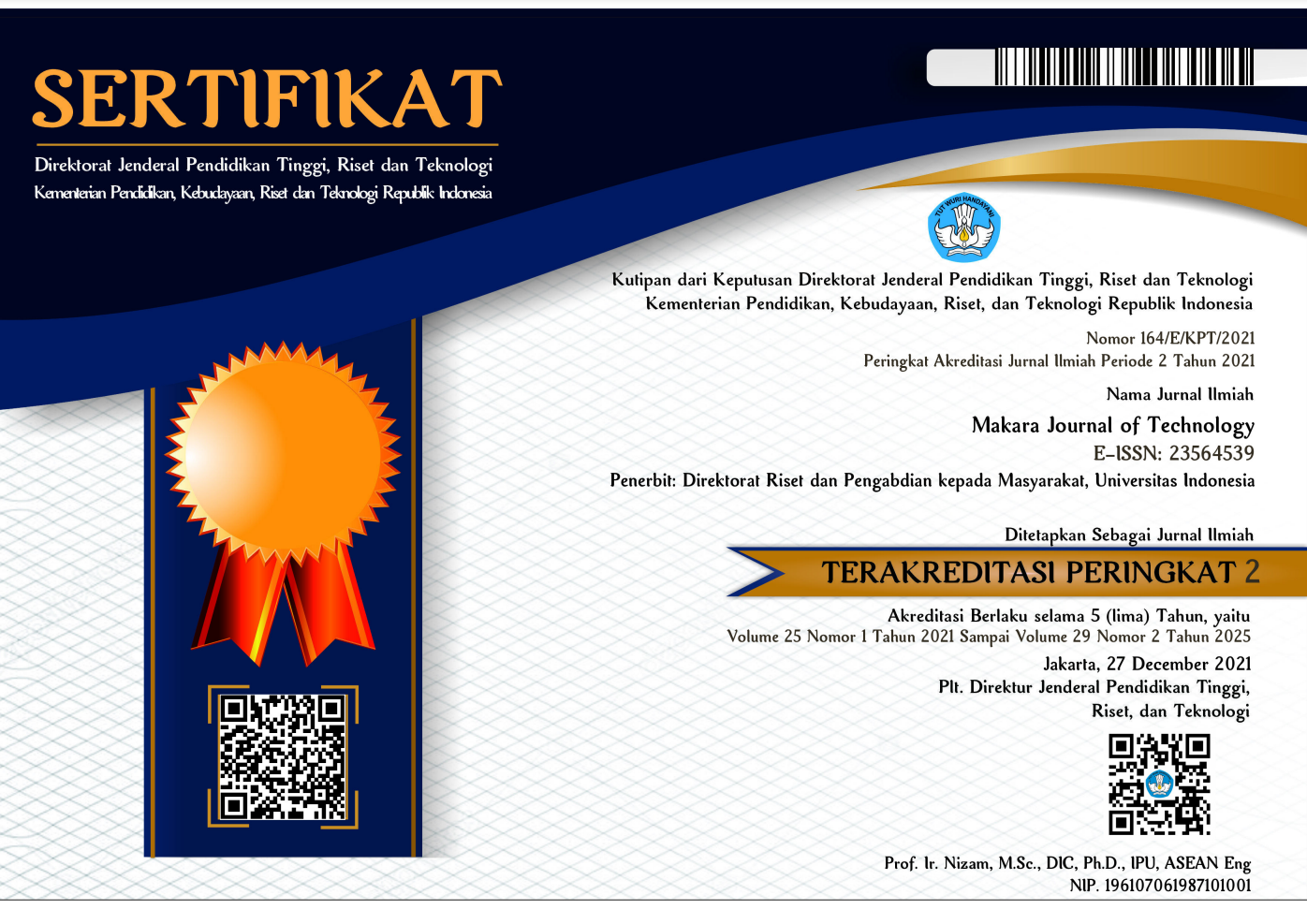Abstract
This research is aimed at studying the relationship between rubber mixing processes and curing characteristics of natural rubber. The curing characteristic analysis was carried out through a natural rubber formula having been masticated and mixed, followed by curing. As many as four mastication methods were finely applied; each respected four sequences of rubber mixing process. In the first method, rubber was masticated for 5 minutes and then rubber chemicals and carbon black N 330 were simultaneously added. In the second and the third methods, rubber was masticated for 1 minute and then carbon blacks and rubber chemicals were also simultaneously added but using different type of fillers. In the fourth method, rubber was masticated for 3 minutes and then rubber chemicals and carbon black were subsequently added. The additions of rubber chemicals and carbon blacks to the masticated rubber were distinguished by the sequence and time allocated for each mixing process. The carbon blacks were added in two stages by which 10 phr was added first and the remaining 40 phr was added later along with oil. In another method, ratios of the carbon blacks addition (as done in the first and the second stages) were 20:30, 30:20, and 40:10. The examination results showed that rubber mixing process gave an impact on the changes of curing characteristics. They were much affected by the method of carbon black addition. The mixing temperature also had an effect on both curing time and curing rate in which the higher the mixing temperature, the lower the curing time and curing rate. Vulcanization temperature also affected the curing time and curing rate in which the higher the vulcanization temperature, the lower the curing time and the higher the curing rate. Lastly, particle size of carbon black also gave an impact on the curing time and curing rate in which the smaller the particle size, the lower the curing time and the higher the curing rate.
Bahasa Abstract
Pengaruh Proses Penggilingan Karet terhadap Karakteristik Vulkanisasi Karet Alam. Tujuan penelitian ini adalah untuk mempelajari hubungan antara proses penggilingan karet dan karakteristik vulkanisasi karet alam. Analisis karakteristik vulkanisasi dilakukan dengan merancang formula karet alam yang dimastikasi dan digiling, kemudian diikuti dengan pengamatan reaksi vulkanisasi. Ada empat metode mastikasi yang masing-masing metode diikuti oleh empat urutan proses pencampuran karet. Metode pertama, karet dimastikasi selama 5 menit dan kemudian diikuti penambahan bahan kimia karet dan carbon black N 330 secara simultan. Metode kedua dan ketiga, karet dimastikasi selama 1 menit kemudian carbon black dan bahan kimia karet ditambahkan secara simulan tetapi menggunakan bahan mengisi dengan tipe yang berbeda. Metode keempat, karet dimastikasi selama 3 menit dan kemudian carbon black ditambahkan dahulu lalu diikuti dengan penambahan bahan kimia karet. Penambahan bahan kimia karet dan carbon black ke dalam karet dibedakan atas urutan dan waktu yang dibutuhkan untuk masing-masing proses pencampuran. Carbon black ditambahkan dalam dua kali, yang pertama 10 phr ditambahkan kemudian sisa carbon black 40 phr ditambahkan kemudian bersamaan dengan penambahan minyak. Metode yang lain, nisbah penambahan carbon black (penambahn pertama dan penambahan kedua bersamaan dengan minyak) adalah 20:30, 30:20, dan 40:10. Hasilnya menunjukkan bahwa proses penggilingan karet mempengaruhi perubahan karakteristik vulkanisasi. Ini dipengaruhi oleh metode penambahan carbon black. Suhu penggilingan juga mempengaruhi waktu dan laju vulkanisasi, di mana semakin tinggi suhu penggilingan, semakin rendah waktu dan laju vulkanisasi. Suhu vulkanisasi juga mempengaruhi waktu dan laju vulkanisasi dengan semakin tinggi suhu vulkanisasi, semakin rendah waktu vulkanisasi dan semakin tinggi laju vulkanisasi. Selanjutnya, ukuran partikel carbon black juga mempengaruhi waktu dan laju vulkanisasi di mana semakin kecil ukuran partikel, semakin rendah waktu vulkanisasi dan semakin tinggi laju vulkanisasi.
References
- P.L. Bideau, J.P. Plateau, P. Dutournie, P. Glouannce. Intl. J. Thermal Sci. 48 (2000) 573.
- M. Jaunich, W. Stark, B. Hoster, Polymer Testing. 28 (2009) 84.
- W. Salgueiro, A. Samoza, I.L. Torriani, A.J. Marzocca, J. Polym. Sci. Part B: Polym Phys. 45 (2007) 2966.
- R.J. Pazur, F.J. Walker, M.I. Plymout, Kautschuk Gummi Kunststoffe. Jan/Feb (2011)16.
- S.H. Chough, D-H. Chang, J. Appl. Polym. Sci. 6l (1996) 449.
- M.A Manchado, M. Arroyo, J. Herrero, J. Biagiotti, J. Appl. Polym. Sci. 89 (2003) 1.
- R. Ding, A.I. Leonov, J. Appl. Polym. Sci. 61 (1996) 455.
- G.R. Cotton, Rubber Chem. Technol. 45 (1972) 124.
- M. Gerspacker, L. Niliel, H.Y. Yang, C.P. O’Farrel, G.A. Schwartz, Paper Presented at a Meeting of the Rubber Division, American Chemical Society, USA, 2001.
- R.N. Mahaling, S. Kumat, T. Rath, C.K. Das, J. Elas. Plast. 39 (2007) 253.
- S.S. Choi, J. Appl. Polym. Sci. 93 (2004) 1001.
- S.S. Choi, K.J. Hwang, B.T. Kim, J. Appl. Polym. Sci. 98 (2005) 2282.
- P.Y. Wang, H.L. Qian, H.P. Yu, J. Chen, J. Appl. Polym. Sci. 88 (2003) 680.
- M.A. Fath, Rubber World 208 (1993) 15.
- M.J. Wang, In Proceedings of International Rubber Conference (IRC), France, 2006.
- M.J. Wang, Rubber Chem. Technol. 71 (1998) 520.
- M.J. Wang, Paper Presented at a Meeting of the Rubber Division, American Chemical Society, USA, 1998.
- F.M. Dannenberg, Rubber Chem. Technol. 59 (1986) 512.
- N. Tricas, E.V. Escales, S. Barros, Afinidad. 59 (2002) 337.
- S. Wolff, M.J. Wang, E.H. Tan, Rubber Chem. Technol. 66 (1993) 163.
- B. Meissner, Rubber Chem. Technol. 68 (1995) 297.
- P.K. Pal, A.K. Bhowmick, S.K. De, Rubber Chem. Technol. 55 (1982) 23.
- J.B. Horn, B.B. Boonstra, In: C.M. Blow, C. Hephurn, Rubber Technology and Manufacture. 2nd, Butterworth Scientific, London, 1982 p.202 and p.269.
- S. Qian, J. Huang, W. Guo, Chifei Wu, J. Macromol Sci. Part B: Physics. 46 (2007) 453.
Recommended Citation
Hasan, Abu; Rochmadi, Rochmadi; Sulistyo, Hary; and Honggokusumo, Suharto
(2012)
"The Effect of Rubber Mixing Process on The Curing Characteristics of Natural Rubber,"
Makara Journal of Technology: Vol. 16:
Iss.
2, Article 3.
DOI: 10.7454/mst.v16i2.1508
Available at:
https://scholarhub.ui.ac.id/mjt/vol16/iss2/3
Included in
Chemical Engineering Commons, Civil Engineering Commons, Computer Engineering Commons, Electrical and Electronics Commons, Metallurgy Commons, Ocean Engineering Commons, Structural Engineering Commons




